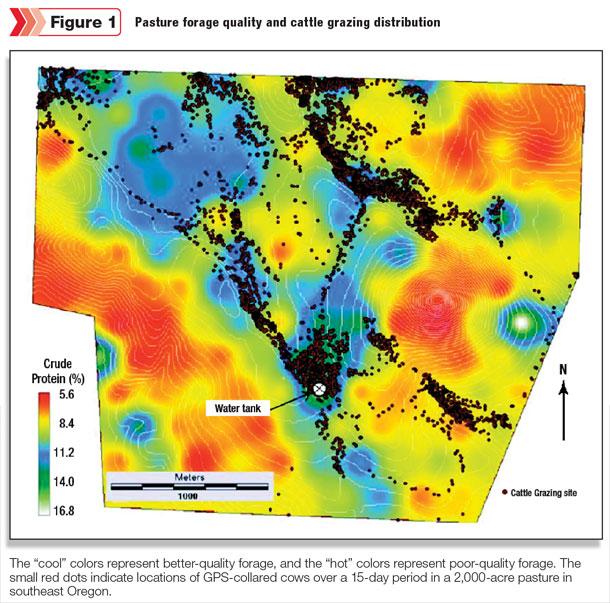However, with cattle grazing arid/semi-arid rangelands where large, extensive pastures with rough topography are common, additional management challenges have resulted in another objective to consider when designing a supplementation program: modification of grazing behavior.
Cattle tend to graze areas with gentle terrain and proximity to water while avoiding those areas more distant from water and with steeper slopes. This can concentrate grazing in certain locations year after year, resulting in localized overgrazing while significant portions of the pasture are rarely visited and have abundant forage.
Recent research has shown strategic supplementation can attract cattle to underutilized locations within a pasture or minimize the environmental impact of grazing riparian areas.
However, regardless of the objective, supplementation can be expensive, and a reoccurring problem faced by beef producers is deciding when, and with what, to supplement cattle on pasture.
Development of a supplementation program
Objectives
The first step in considering a supplementation program is to determine the objective of the program and if supplementation is necessary to meet the objective.
Objectives normally include an expected level of animal performance, modification of grazing behavior and pasture utilization or some combination thereof.
To determine if supplemental nutrients are necessary for an expected level of performance, the manager needs specific information, including:
1. Estimate of forage quality
2. Estimate of available forage
3. Cattle nutritional status
4. Cattle nutrient requirements
5. Anticipated response to supplementation
This information allows for design of a supplement that minimizes the chance of overfeeding or underfeeding nutrients, thereby reducing supplementation costs and improving the efficiency of the supplementation program.
To modify grazing behavior, managers need to identify potential supplement locations which, in large extensive pastures with rough topography, requires knowledge of relevant pasture/landscape attributes, such as:
1. Location and seasonality of grazing preferences
2. Differences in forage quality across the landscape/pasture (Figure 1 illustrates how forage quality influenced cow grazing distribution.)

3. Current and potential watering locations; riparian areas
4. Fire history
5. Accessibility
This information can be used to develop a supplementation program to lure cattle to underutilized areas of a pasture, thus improving grazing distribution.
Work out of Montana State University documented the ability of molasses-based, low-moisture block supplements to attract cattle to areas normally not grazed because of rough terrain or distance from water and increased forage utilization from 15 to 20 percent compared with the same area before supplement placement.
Also, strategic placement of protein blocks was used by researchers from University of California – Davis to move cattle away from riparian areas toward the less environmentally sensitive uplands and reduced the time spent grazing in riparian areas from 37 percent without supplement to 14.5 percent by placing supplement in the uplands.
Type of supplement
Choosing a type of supplement depends on supplementation objectives, feedstuff availability and cost. The primary types of supplements can be loosely characterized as protein, energy and salt/mineral.
Most common sources of supplemental protein are derived from oilseeds (soybeans, cottonseed, etc.). These offer several advantages, including a high concentration of crude protein (CP) and energy densities similar to cereal grains.
Thus, while we usually consider these supplements as protein sources, they also provide significant energy contributions. In addition, sources of non-protein nitrogen (specifically urea) are attractive as CP supplements because of their high concentration of CP and low cost per unit of CP.
Also, alfalfa is often a supplement of choice because of competitive pricing, accessibility, ease of feeding and relatively high concentrations of both CP and energy.
Energy supplements for cattle on pasture (normally cereal grains or fats) are required when energy availability from grazed forages is limited for expected performance. Many byproduct feeds normally thought of as energy supplements, such as dried distillers grains, soybean hulls, wheat middlings and beet pulp, can also provide supplemental CP.
Salt/mineral supplements are formulated based on local knowledge of cattle mineral status and forage mineral content.
Supplement delivery method
The time and labor available to the beef producer, as well as pasture size, pasture topography and number of animals, need to be considered when selecting a delivery method.
-
Hand-fed. Hand-feeding allows measured control of the amount of supplement provided to the cattle with little control over individual supplement intake.
Hand-feeding daily allows aggressive animals to consume disproportionately greater amounts of supplement compared with those that are more submissive.
Providing approximately 1 meter of feeding space per animal can minimize the effects of dominant animals. Less space excludes some animals from consuming supplement, and more space appears to increase the impact of aggressive animals.
-
Self-fed. Self-feeding allows animals continuous access to supplement, thereby decreasing competition and the number of non-feeders. Research with self-fed supplements (such as liquid, blocks and tubs) has demonstrated a large degree of variation in individual animal intake.
In addition, most self-fed supplements are more expensive than hand-fed supplements when expressed per pound of supplemental nutrient.
The primary advantages of self-feeding include ease of application, minimal investment in equipment and a relatively low labor requirement. Types of commonly used self-fed supplements include blocks, tubs, liquid and salt/mineral mixes.
-
Hand-fed vs. self-fed. Pasture size and accessibility, herd size and available time, labor and equipment will dictate which supplement delivery method is most appropriate for an individual program.
Delivery method is not as critical in small pastures as in extensive situations because pasture topography and site of supplementation have less effect on grazing distribution and grazing time. However, daily hand-feeding large numbers of cattle in extensive pastures can decrease grazing time and impair their ability to uniformly graze the entire pasture due to anticipation of supplementation.
Also, the required infrastructure and impracticality of providing the required amount of supplement on a regular schedule limits its use in large extensive pastures.
Infrequent CP supplementation is an option to consider when designing a hand-fed supplementation program. Hand-feeding a supplement as infrequently as once every seven days can be an effective means of providing protein to ruminants while maintaining acceptable animal performance.
However, extreme caution should be used with infrequent supplementation of urea due to a lack of related research and the problems associated with excessive urea intake and urea toxicity.
Self-feeding and infrequent hand-feeding may reduce the anticipation of being fed and encourage longer grazing times, thereby improving livestock distribution and forage utilization. Additionally, as mentioned previously, cattle grazing behavior and distribution can be altered by strategic placement of self-fed supplements.
Summary
The “ideal” supplement is one that best fits management objectives, is easiest to handle and present to the target animals, and is the most economical to purchase and feed.
Supplementation strategies will vary from one operation to the next depending on the quantity of forage available, feedstuff availability, labor and equipment, the size, extent and type of operation, and the ranch’s goals.
In addition, a successful supplementation program should take advantage of the operation’s available resources, with major emphasis on long-term management and economics. Therefore, economics and sustained production, rather than maximal animal productivity, should determine the most appropriate supplementation strategy. ![]()
-
David Bohnert
- Associate Professor
- Eastern Oregon Agriculture Research Center
- Oregon State University
- Email David Bohnert








